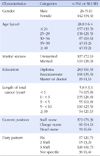Abstract
Purpose
The purpose of this study was to identify the relationship between the practice environment of nursing and the critical thinking disposition of clinical nurses in local general hospitals.
Methods
A convenience sample of 468 registered nurses was obtained from three local general hospitals. Data were collected by a self-administered questionnaire during November, 2012. The survey tools were the K-PES-NWI verified by Cho et al (2011) and the critical thinking disposition instrument developed by Yoon (2004). Data were analyzed using descriptive statistics, one-way ANOVA with Scheffé test and multiple regression with SPSS/WIN 18.0.
Results
The mean score for practice environment of nursing was 3.3±0.4 and for critical thinking disposition, 2.3±0.4. There were statistically significant differences in critical thinking disposition according to age, education, length of career, current position, and marital status. In multivariate analysis, factors related to critical thinking disposition were collegial nurse-physician relations and education level.
Conclusion
The results of the study indicate that collegial nurse-physician relations in the nursing practice environment are related to nurses' critical thinking disposition, and thus, it is important to improve the practice environment as well using individual approaches including on-the-job training to improve nurses' critical thinking disposition.
References
1. Park S, Kwon IG. Factors influencing nurses' clinical decision making: Focusing on critical thinking disposition. J Korean Acad Nurs. 2007; 37(6):863–871.
2. Ennis R. Critical thinking: A streamlined conception. Teach Philos. 1991; 14(1):44–48.
3. Sung KS. The education for critical thinking. J Educ Idea. 2010; 24(3):155–172.
4. Yoon J. Development of an instrument for the measurement of critical thinking disposition: In nursing [dissertation]. Seoul: The Catholic University of Korea;2004. 10–35.
5. Fero LJ, Witsberger CM, Wesmiller SW, Zullo TG, Hoffman LA. Critical thinking ability of new graduate and experienced nurses. J Adv Nurs. 2009; 65(1):139–148. http://dx.doi.org/10.1111/j.1365-2648.2008.04834.x.
6. Wangensteen S, Johansson IS, Björkström ME, Nordström G. Critical thinking dispositions among newly graduated nurses. J Adv Nurs. 2010; 66(10):2170–2181. http://dx.doi.org/10.1111/j.1365-2648.2010.05282.x.
7. Feng RC, Chen MJ, Chen MC, Pai YC. Critical thinking competence and disposition of clinical nurses in a medical center. J Nurs Res. 2010; 18(2):77–87. http://dx.doi.org/10.1097/JNR.0b013e3181dda6f60.
8. Kawashima A, Petrini MA. Study of critical thinking skills in nursing students and nurses in Japan. Nurse Educ Today. 2004; 24(4):286–292. http://dx.doi.org/10.1016/j.nedt.2004.02.001.
9. Lee HJ. Study on critical thinking disposition and empowerment of clinical nurses [master's thesis]. Seoul: Kyung Hee University;2002. 55–57.
10. Park JA. Critical thinking disposition and clinical decision making of emergency nurses [master's thesis]. Kyeonggi-do: Ajou University;2012. 15–23.
11. Sung MH, Eum OB. Relationships between critical thinking disposition, professional nursing competence and job satisfaction in clinical nurses. J Korean Acad Nurs Adm. 2009; 15(1):26–36.
12. Chan ZC. A systematic review of critical thinking in nursing education. Nurse Educ Today. 2013; 33:236–240. http://dx.doi.org/10.1016/j.nedt.2013.01.007.
13. Myrick F. Preceptorship and critical thinking in nursing education. J Nurs Educ. 2002; 41(4):154–164.
14. Kaya H, Sen H, Kececi A. Critical thinking in nursing education: Anatomy of a course. New Educ Rev. 2011; 23(1):159–173.
15. Mangena A, Chabeli MM. Strategies to overcome obstacles in the facilitation of critical thinking in nursing education. Nurse Educ Today. 2005; 25(4):291–298. http://dx.doi.org/10.1016/j.nedt.2005.01.012.
16. Lake ET, Friese CR. Variations in nursing practice environment: Relation to staffing and hospital characteristics. Nurs Res. 2006; 55(1):1–9.
17. Fowler LP. Improving critical thinking in nursing practice. J Nurses Staff Dev. 1998; 14(4):183–187.
18. Bittner NP, Tobin E. Critical thinking: Strategies for clinical practice. J Nurses Staff Dev. 1998; 14(6):267–272.
19. Raterink G. Critical thinking: Reported enhancers and barriers by nurses in long-term care: Implications for staff development. J Nurses Staff Dev. 2011; 27(3):136–142. http://dx.doi.org/10.1097/NND.0b013e318217b3f3.
20. Choi H, Cho D. Influence of nurses performance with critical thinking and problem solving process. Korean J Women Health Nurs. 2011; 17(3):265–274. http://dx.doi.org/10.4069/kjwhn.2011.17.3.265.
21. Lake ET. Development of the practice environment scale of the nursing work index. Res Nurs Health. 2002; 25:176–188. http://dx.doi.org/10.1002/nur.10032.
22. Cho E, Choi M, Kim EY, Yoo IY, Lee NJ. Construct validity and reliability of the Korean version of the practice environment scale of nursing work index for Korean nurses. J Korean Acad Nurs. 2011; 41(3):325–332. http://dx.doi.org/10.4040/jkan.2011.41.3.325.
23. Chaung SK. Critical thinking disposition, problem solving ability and clinical competence in nursing students. J Korean Acad Fundam Nurs. 2011; 18(1):71–78.
24. Kwon JO, Kim EY. Impact of unit-level nurse practice environment on nurse turnover intention in the small and medium sized hospitals. J Korean Acad Nurs Adm. 2012; 18(4):414–423. http://dx.doi.org/10.11111/jkana.2012.18.4.414.
25. Lee MH. A comparative study on nursing practice environment, professionalism, and job satisfaction according to hospital size [master's thesis]. Cheonan: Dankook University;2012. 18–35.
26. Jung SC, Jung D. Relationship between critical thinking disposition, clinical decision making and job satisfaction of cancer center nurses. J Korean Acad Nurs Adm. 2011; 17(4):443–450.
27. Benner P. From novice to expert. Am J Nurs. 1982; 82(3):402–407.
28. Freire P. Pedagogy of the oppressed. 30th anniversary ed. New York: Continuum Press;2000. p. 43–70.
29. Boschma G, Einboden R, Groening M, Jackson C, MacPhee M, Marshall H, et al. Strengthening communication education in an undergraduate nursing curriculum. Int J Nurs Educ Scholarsh. 2010; 7:Article28. http://dx.doi.org/10.2202/1548-923X.2043.
30. Weinberg DB. Code green: Money-driven hospitals and the dismantling of nursing. Ithaca: ILR Press;2003. p. 1–18.




 PDF
PDF ePub
ePub Citation
Citation Print
Print






 XML Download
XML Download